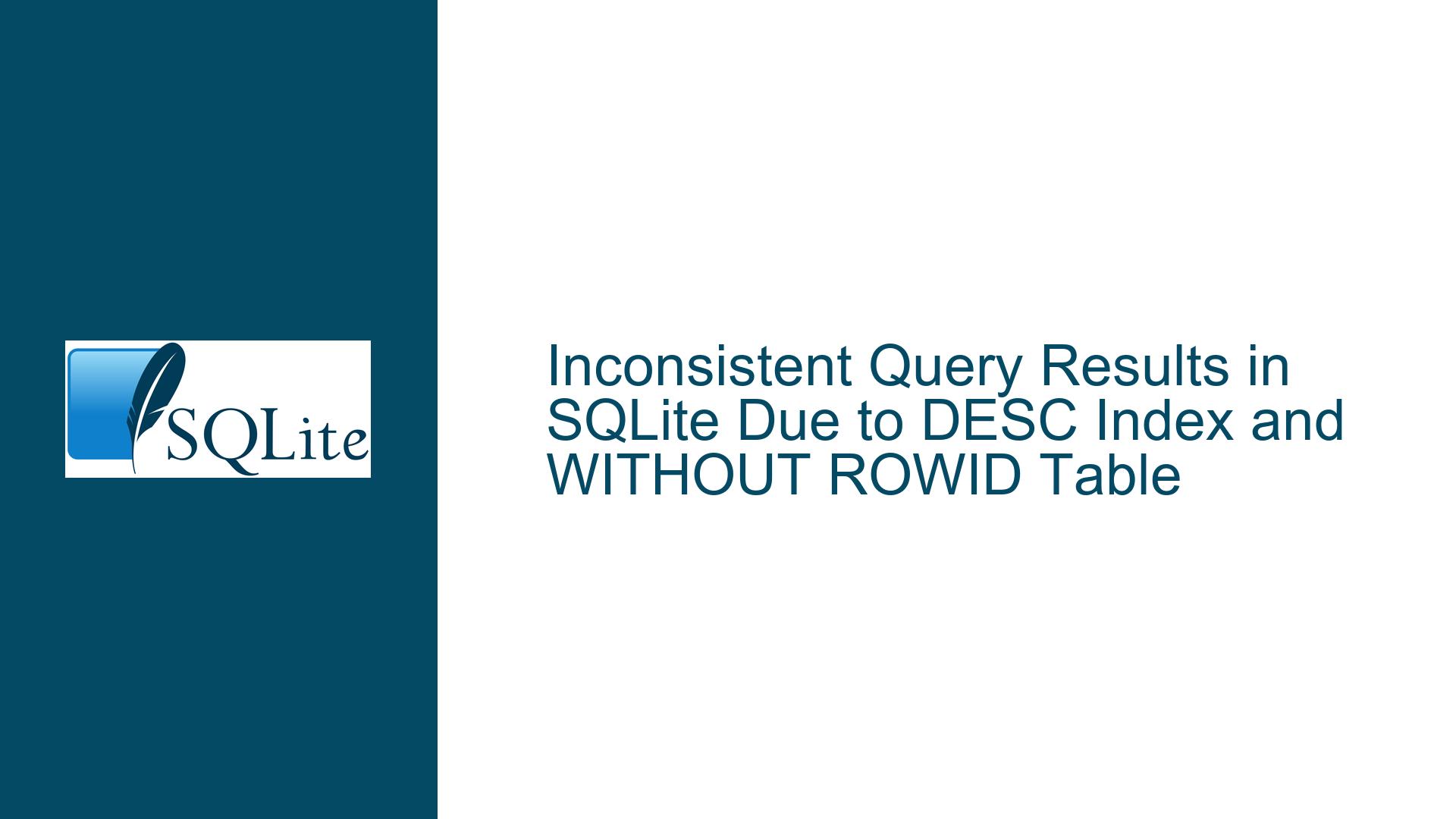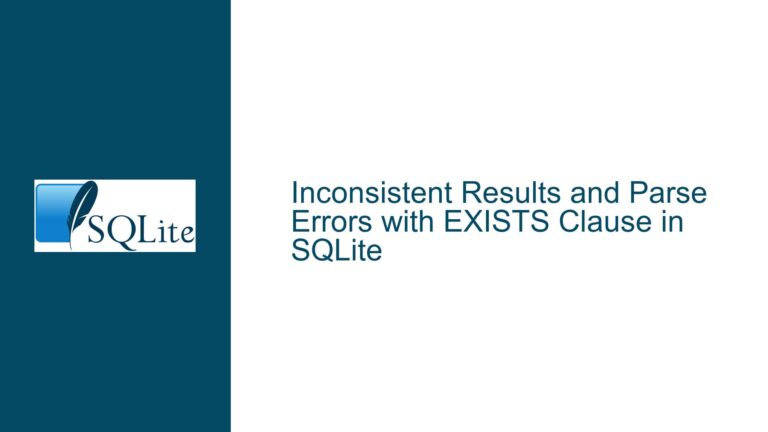Inconsistent Query Results in SQLite Due to DESC Index and WITHOUT ROWID Table
Inconsistent Query Results with DESC Index and WITHOUT ROWID Table
When working with SQLite, particularly in scenarios involving DESC indexes and WITHOUT ROWID tables, developers may encounter inconsistent query results. This issue manifests when queries that should logically return the same results instead produce different outputs. For instance, a query filtering on a column with a DESC index and another column in a WITHOUT ROWID table might return expected results in one case but an empty set in another, even though the filtering conditions are logically equivalent.
The core of the problem lies in the interaction between the DESC keyword, the WITHOUT ROWID table structure, and the presence of secondary indexes. When a table is defined as WITHOUT ROWID, it uses the primary key as the clustering key, which affects how data is stored and retrieved. The DESC keyword on the primary key further complicates this by altering the order in which the index is traversed. These factors, combined with the presence of a secondary index, can lead to unexpected behavior in query execution plans, resulting in inconsistent outputs.
DESC Index and WITHOUT ROWID Interaction Causing Query Plan Misalignment
The inconsistency in query results can be attributed to the way SQLite’s query planner handles DESC indexes and WITHOUT ROWID tables. When a table is defined with WITHOUT ROWID, the primary key is used as the clustering key, meaning the data is physically ordered by the primary key. If the primary key is defined with DESC, the data is stored in descending order, which affects how the index is traversed during query execution.
The presence of a secondary index, such as v3 on column v2, introduces additional complexity. SQLite’s query planner must decide whether to use the primary key index or the secondary index to execute the query. In some cases, the planner may choose to use the secondary index, which does not account for the DESC ordering of the primary key. This misalignment between the primary key’s ordering and the secondary index’s structure can lead to incorrect query results, particularly when filtering on both the primary key and the indexed column.
For example, in the query SELECT * FROM v0 WHERE v2 = 10 AND v1 < 11, the query planner might opt to use the secondary index on v2 to quickly locate rows where v2 = 10. However, because the primary key v1 is defined with DESC, the secondary index does not correctly reflect the ordering of v1, leading to an empty result set even though rows matching the condition exist.
Resolving Inconsistent Results by Adjusting Schema and Query Execution
To address the issue of inconsistent query results, developers can take several approaches, each targeting a different aspect of the schema or query execution. The first and most straightforward solution is to remove the DESC keyword from the primary key definition. This ensures that the primary key is stored in ascending order, aligning with the default behavior of SQLite’s indexing and query planning mechanisms. By doing so, the query planner can correctly interpret the ordering of the primary key and produce consistent results.
Another approach is to eliminate the WITHOUT ROWID clause from the table definition. While WITHOUT ROWID tables offer performance benefits in certain scenarios, they also introduce complexities in query planning, especially when combined with DESC indexes. By reverting to a standard rowid table, the query planner can leverage SQLite’s default indexing strategy, which is less prone to misalignment issues.
A third option is to remove the secondary index on v2. Without the secondary index, the query planner is forced to use the primary key index, which correctly reflects the DESC ordering of v1. This ensures that queries filtering on both v1 and v2 produce consistent results. However, this approach may have performance implications, as the absence of a secondary index could lead to slower query execution for certain types of queries.
In addition to these schema adjustments, developers can also consider using explicit query hints to guide the query planner. For example, the INDEXED BY clause can be used to force the query planner to use a specific index, ensuring that the correct index is used for query execution. This approach requires a deep understanding of the query planner’s behavior and should be used judiciously to avoid unintended side effects.
Finally, developers should ensure that their SQLite installation is up to date. The issue described in this post was fixed in a specific check-in (f65c929bf189cf5c), and updating to a version that includes this fix will resolve the inconsistency without requiring any schema changes. Regularly updating SQLite is a best practice that helps avoid known issues and ensures access to the latest features and optimizations.
By carefully considering these solutions and their implications, developers can effectively resolve the issue of inconsistent query results in SQLite, ensuring that their applications behave as expected and deliver reliable performance.






